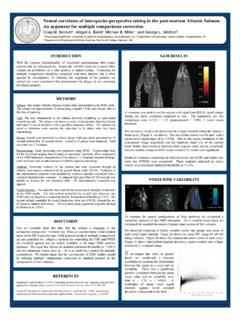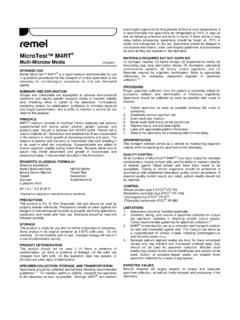Transcription of Sugars intake for adults and children - WHO
1 Guideline: Sugars intake for adults and children WHO| Guideline i Sugars intake for adults and children Guideline: Sugars intake for adults and children WHO Library Cataloguing-in-Publication Data Guideline: Sugars intake for adults and children . Sucrose administration and dosage. Caries prevention and control. prevention and control. Disease prevention and control. intake . Habits. Dietary Allowances. Health Organization. ISBN 978 92 4 154902 8 (NLM classification: QU ). World Health Organization, 2015. All rights reserved. Publications of the World Health Organization are available on the WHO website ( ) or can be purchased from WHO Press, World Health Organization, 20 Avenue Appia, 1211 Geneva 27, Switzerland (tel.: +41 22 791 3264; fax: +41 22 791 4857; e-mail: Requests for permission to reproduce or translate WHO publications whether for sale or for non-commercial distribution should be addressed to WHO Press through the WHO website ( ).)
2 The designations employed and the presentation of the material in this publication do not imply the expression of any opinion whatsoever on the part of the World Health Organization concerning the legal status of any country, territory, city or area or of its authorities, or concerning the delimitation of its frontiers or boundaries. Dotted and dashed lines on maps represent approximate border lines for which there may not yet be full agreement. The mention of specific companies or of certain manufacturers' products does not imply that they are endorsed or recommended by the World Health Organization in preference to others of a similar nature that are not mentioned. Errors and omissions excepted, the names of proprietary products are distinguished by initial capital letters.
3 All reasonable precautions have been taken by the World Health Organization to verify the information contained in this publication. However, the published material is being distributed without warranty of any kind, either expressed or implied. The responsibility for the interpretation and use of the material lies with the reader. In no event shall the World Health Organization be liable for damages arising from its use. Design and layout: Alberto March Printed by the WHO Document Production Services, Geneva, Switzerland Suggested citation Guideline: Sugars intake for adults and children . Geneva: World Health Organization; 2015. WHO| Guideline iv Sugars intake for adults and children Contents Acknowledgements vii Abbreviations and acronyms viii Executive summary 1.
4 Introduction 6. Scope and purpose 6. Background 7. Guideline development process 8. Advisory groups 8. Guideline development group 8. External peer-review group 8. Public consultation 9. Scoping of the guideline, evidence appraisal and decision-making 10. Management of conflicts of interest 11. Summary of evidence 12. Body weight 12. Dental caries 13. Recommendations and remarks 16. Recommendations 16. Remarks 16. Dissemination, translation and implementation, and monitoring and evaluation 18. Dissemination 18. Translation and implementation 18. Monitoring and evaluation of guideline implementation 19. Research gaps and future initiatives 20. Implications for future research 20. Updating the guideline 20. WHO| Guideline v Sugars intake for adults and children Annex 1 GRADE evidence profiles 21.
5 Annex 2 WHO Secretariat 27. Annex 3 Members of the WHO Steering Committee for Nutrition Guideline Development 2012 - 2014 29. Annex 4 Members of the guideline development group (NUGAG Subgroup on Diet and Health) and external resource persons 2012 2014 31. Annex 5 External peer-review group 33. Annex 6 Priority questions in the format of population, intervention, control and outcomes (PICO) 34. Annex 7 Summary of considerations for determining the strength of the recommendations 37. Annex 8 Management of conflict of interest 38. References 46. WHO| Guideline vi Sugars intake for adults and children Acknowledgements Technical support This guideline was coordinated by Dr Chizuru Nishida, Coordinator of the Nutrition Policy and Scientific Advice Unit (NPU) in the WHO Department of Nutrition for Health and Development (NHD), with technical support and inputs from Dr Jason Montez, Technical Officer, NPU, and Dr Francesco Branca, Director, NHD.
6 WHO gratefully acknowledges the technical input and expert advice provided by the members of the WHO Nutrition Guidance Expert Advisory Group Subgroup on Diet and Health, and by the external experts and resource persons for the development of this guideline, including the authors of the background systematic reviews. WHO also recognizes the valuable contributions made by the external peer reviewers and interested stakeholders who provided comments in response to public consultation. Thanks are due to the members of the WHO Steering Committee for Nutrition Guidelines Development and the WHO Guidelines Review Committee (GRC) for their support and guidance throughout the guideline development process; special appreciation is given to Dr Susan Norris, GRC Secretariat, and Dr Charles Penn, Chair of GRC.
7 Deep appreciation is expressed to Mr Issa Matta from the WHO Office of the Legal Counsel for his support and valuable guidance in the management of the conflicts of interest procedures. Special thanks are also due to colleagues in the WHO Department of Communications for their support with media communications throughout the guideline development process, particularly Ms Fadela Chaib, Mrs Kimberly Chriscaden, Ms Christine Feig, Mr Paul Garwood, Mr Gregory Hartl, Mr Tarik Jasarevic, Ms Olivia Lawe-Davies and Mr Glenn Thomas. Acknowledgement is made to the staff of NPU, especially Ms Emma Kennedy, Assistant to the Coordinator, for providing administrative and logistic support throughout the guideline development process, and Ms Kaia Engesveen, Ms Line Vogt and Dr Katharina da Silva Lopes, for supporting the guideline publication process.
8 WHO also acknowledges Dr Hilary Cadman from Cadman Editing Services in Australia for technical editing of this guideline, and Mr Alberto March from Grafmac Inc in Spain for the cover design and layout. Financial support WHO expresses special appreciation to the following offices, organizations and institutions, for providing financial support for the guideline development work: The Ministry of Health, Labour and Welfare of the Government of Japan;. The Korean Food and Drug Administration, through grants to the Korea Health Industry Development Institute (a research institute affiliated to the Korean Government);. Zhejiang University in Hangzhou, China; and The WHO Regional Office for Europe. WHO| Guideline vii Sugars intake for adults and children Abbreviations and acronyms BMI body mass index CI confidence interval CVD cardiovascular disease eLENA WHO e-Library of Evidence for Nutrition Actions FAO Food and Agriculture Organization of the United Nations GINA WHO Global database on the Implementation of Nutrition Action GRADE Grading of Recommendations Assessment, Development and Evaluation NCD noncommunicable disease NGO nongovernmental organization NHD WHO Department of Nutrition for Health and Development NUGAG WHO Nutrition Guidance Expert Advisory Group OR odds ratio PICO population, intervention.
9 Comparison and outcome RCT randomized controlled trial SD standard deviation UK United Kingdom of Great Britain and Northern Ireland UN United Nations WHO World Health Organization WHO| Guideline viii Sugars intake for adults and children Executive summary Background Noncommunicable diseases (NCDs) are the leading causes of death and were responsible for 38 million (68%) of the world's 56 million deaths in 2012 (1). More than 40% of those deaths (16 million) were premature ( under the age of 70 years). Almost three quarters of all NCD deaths (28 million), and the majority of premature deaths (82%), occurred in low- and middle-income countries. Modifiable risk factors such as poor diet and physical inactivity are some of the most common causes of NCDs; they are also risk factors for obesity1 an independent risk factor for many NCDs which is also rapidly increasing globally (2).
10 A high level of free sugars2 intake is of concern, because of its association with poor dietary quality, obesity and risk of NCDs (3, 4). Free Sugars contribute to the overall energy density of diets, and may promote a positive energy balance (5-7). Sustaining energy balance is critical to maintaining healthy body weight and ensuring optimal nutrient intake (8). There is increasing concern that intake of free Sugars particularly in the form of sugar -sweetened beverages increases overall energy intake and may reduce the intake of foods containing more nutritionally adequate calories, leading to an unhealthy diet, weight gain and increased risk of NCDs (9-13). Another concern is the association between intake of free Sugars and dental caries (3, 4, 14-16).
















